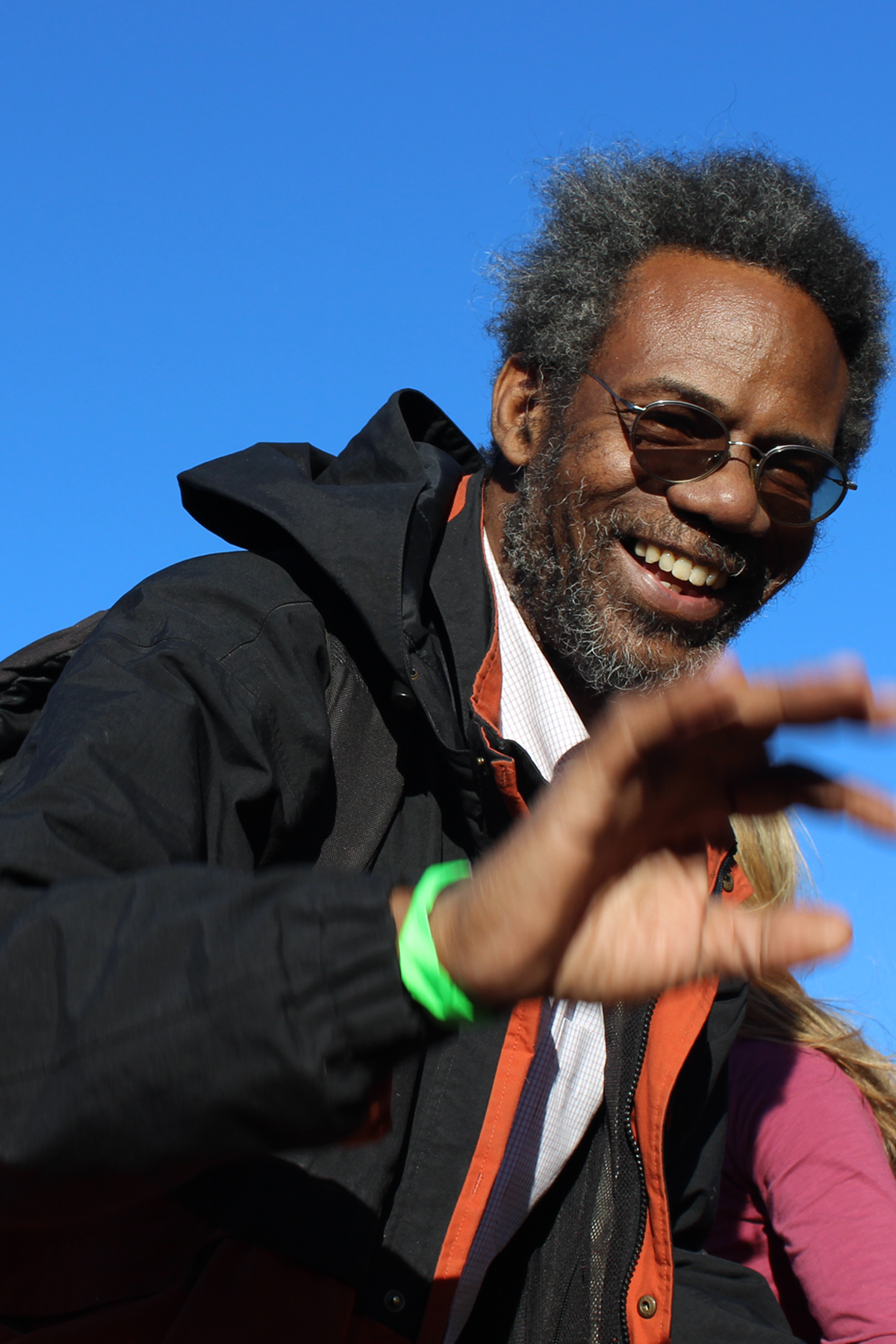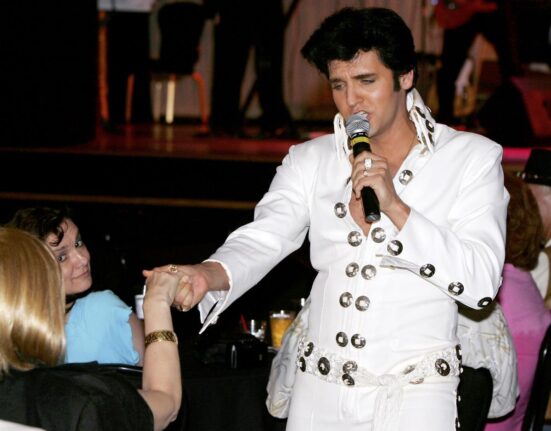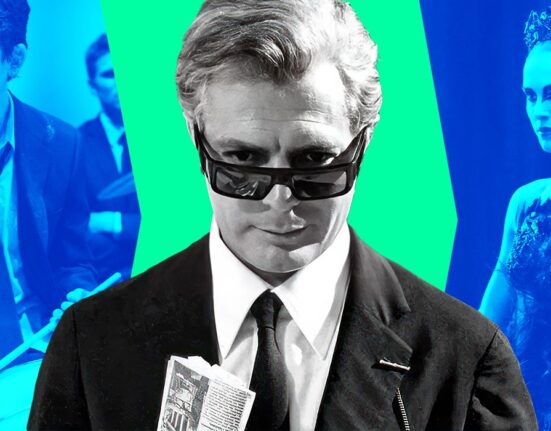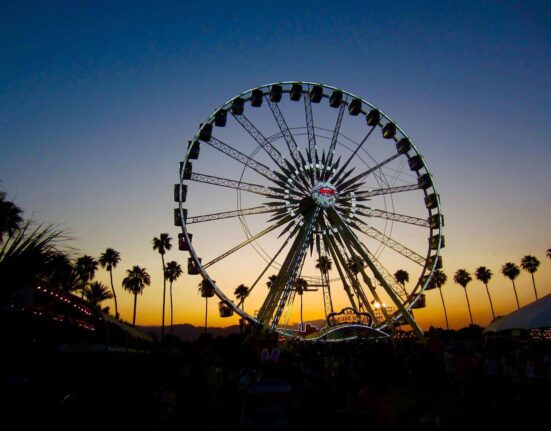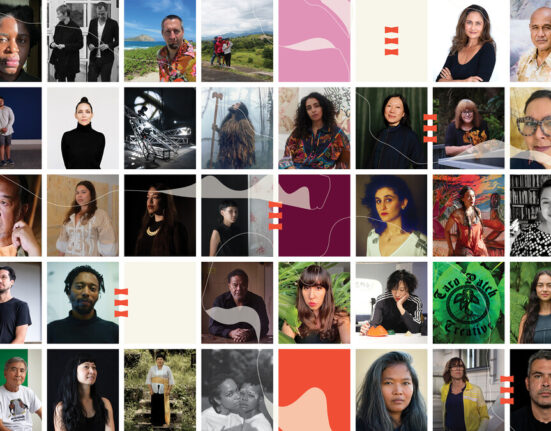Pope.L/Photo courtesy of Jeremiah Hulsebos-Spofford
When the American artist Pope.L died late last December, he was remembered and celebrated around the world, with extensive looks back at his life and work in the New York Times, the Guardian and Artforum. In Chicago, the news hit especially hard.
“He was profoundly invested in the lives of his students and his colleagues and his close friends here,” says artist Theaster Gates. “Through his teaching and through his friendships and mentorship and extended paternalism—in the best way—he was a father to a lot of people in the arts.”
After teaching for two decades at Bates College in Maine, Pope.L came to Chicago in 2012. To Gates, his arrival was a herald. “It was part of the thing that for me started to make Chicago one of the great anchors for contemporary visual art.”
Pope.L was a tenured professor in the Department of Visual Arts (DOVA) at the University of Chicago. The community there is small and tight-knit. Many of the faculty have come of age alongside one another, as artists and teachers and parents. Pope.L, who was a decade or more older than most of them, “changed the pH of the department,” according to Gates.
“He had an ideological and generational mindset that didn’t give a fuck about the market or the prevailing ways of making contemporary art. He was a theater person who was never moved by the seduction of those grand things. His practice was largely a self-driven, internal practice.”
Another of his DOVA colleagues, the sculptor Jeremiah Hulsebos-Spofford, says he was struck by how the “interdisciplinary path” Pope.L laid out proved a course for many artists. “The permission he’s given to do all sorts of experimentation and shift gears dramatically and be okay with not categorizing. I think he had one of the most beautiful minds.”
Pope.L “The Great White Way: 22 Miles, 9 Years, 1 Street,” 2001-02. Digital c-prints on gold fiber silk paper, 10 by 15 in. 25.4 by 38 .1 cm. © Pope.L / Courtesy of the artist and Mitchell-Innes & Nash, New York
Pope.L had a lengthy and prolific life as an artist. Starting in the late 1970s in New York City, he created art across multiple forms: video, sculpture, installation, writing, drawing and performance. What he made and what he did was create a challenge: to see the complexity of things and to think about the layers of meaning embedded in language, objects and symbols, from the American flag to the “Great White Way” of Broadway.
His performances ranged from simple gestures (pouring out a seemingly endless bottle of water in “Flint Water Meets the Mighty Hudson“) to grand excursions (“The Black Factory,” a customized panel truck that traveled the United States, to collect and transform objects people believe to represent “Blackness”).
Pope.L described the poverty and instability of his childhood as “have-not-ness,” saying it “permeates everything I do.” In response to homelessness increasing on the streets of New York, in 1978 Pope.L performed his first “crawl,” in which he dragged his body, using his hands, legs and belly, over long distances and periods of time, sometimes in stages over the course of years. In a recent interview he talked about how many of his close family members had been homeless, saying “When you have that many people in your family suffering from this thing, maybe you think it will happen to you. Like a disease. I wanted to participate in the lack of it.”
For Theaster Gates, “The crawl is a sculpture. It’s the manifestation of thought. On his knees, on his back, on a skateboard in a suit, naked, he was trying to embody the conditions of a people. The thinking that got him to those forms, that’s the thing that impressed me so much. He didn’t write a book about the oppressive nature of race in America. He crawled.”
Pope.L “How Much is that Nigger in the Window a.k.a. Tompkins Square Crawl,” 1991?. Digital c-print on gold fiber silk paper, 10 by 15 in. 25.4 by 38.1 cm.? © Pope.L / Courtesy of the artist and Mitchell-Innes & Nash, New York
Eventually other people joined Pope.L to crawl. Many of his performances seek to draw audiences into their actions. “The Escape,” a 2018 performance in motion across the Art Institute of Chicago, lists the cast as “Four actors, two musicians, thirty-five audience members, Pope.L.” The performance is an interpretation of “The Escape; or, A Leap to Freedom,” an 1858 play by American abolitionist and writer William Wells Brown, who was born into slavery. Though it was never performed in his lifetime, Brown apparently read it aloud to audiences at anti-slavery rallies.
Pope.L’s interpretation of Brown’s work was acclaimed. One reviewer praised his “brilliant and deliberately confounding interpretation,” driven by “errant clues and dead ends of decipherment.” Hulsebos-Spofford considers it a “masterpiece. He implicated the audience in such a direct way, it was really uncomfortable. I thought about it for years afterward.”
Performances that unsettle only to settle in, inside people’s heads or under their skins, seems a hallmark of Pope.L’s work. A version of his 2017 “Whispering Campaign,” originally created for the art exhibition documenta 14, was staged on a traveling barge designed by the art collective Floating Museum. (Hulsebos-Spofford is one of the founders). A sound installation which weaves together the oral histories of migrants, poetry, mythology and other sounds, all in whispers, played through the night. Conjuring an array of communicative acts that play with decipherability—ghost stories, propaganda techniques, gossip and white noise—Hulsebos-Spofford says it unnerved some people.
“Vintage Pope.L,” says Dieter Roelstraete, one of the curators of documenta 14 who invited him to participate. “Totally elusive, evasive, confrontational, weird, off-kilter, humorous… Everything you want from brilliant art.”
Pope.L “Training Painting,” 2019. Acrylic, charcoal, oil, chalk, pastel, ballpoint and graphite on panel; Diptych, overall: 96 by 96 by 2 in. 243.8 by 243.8 by 5.1 cm. © Pope.L / Courtesy of the artist and Mitchell-Innes & Nash, New York
Roelstraete is the curator of the University of Chicago’s Neubauer Collegium for Culture and Society. Over a five-year span he and Pope.L worked on three major projects together: “Whispering Campaign,” “My Kingdom for a Title” at the Neubauer in 2021; and the following year, Pope.L’s first solo exhibition in Berlin, “Between a Figure and a Letter.”
He calls Pope.L one of the greatest artists he has ever worked with. “I’ve not met that many artists in whose presence I really felt, ‘Wow.’ He had such an original mind, so endlessly innovative and inquisitive and probing.”
Along with exhibitions, the two men wrote a book and taught a course together. Throughout, Pope.L could be “complicated, demanding,” and seem to make things more difficult than they had to be, which he attributes to an “unsatisfiable search for complexity” that drove the artist. At the same time, Pope.L was a “very sunny person, always jovial and uplifting about his practice. He was a dear friend. We often hung out. We lunched and bonded a bit around issues pertaining to fatherhood.”
Hulsebos-Spofford says his relationship with Pope.L also revolved around family. Their sons grew up together and attended the same school. They met up almost every Saturday for years “doing kid stuff,” like going to the playground or a movie. “We saw so many together. The whole ‘Avengers’ series… He was so up for terrible movies!” Laughing, he says it turns out the artist had a lot of standing dates, “even on Saturdays. He touched a lot of people’s lives. He had these great routines that built relationships.”
Artist Mami Takahashi is Pope.L’s long-time partner. They met ten years ago in Portland, Oregon, where she was based. Her first impression of him was akin to “a very quiet, smart tiger,” “masculine and wild” in a good way. Takahashi says Pope.L didn’t make friendships easily, often taking years to let his guard down, if at all.
“He had layers of vulnerability. He may talk about being a father with other people who are fathers. But he never talked about his experience as a son in a deep way.” If Pope.L relationships were fraught, Takahashi says they also shaped him. His mom taught him the joy of reading. “She did her best. She was a big part of building who he is [and] a big part of the struggle. Impossible to separate.”
Takahashi says Pope.L found a sense of family elsewhere, with some of the people in New Jersey and New York who he attended university with and who stayed in his life.
Pope.L during a photo shoot with donuts for his show at 52 Walker, December 2022 /Photo: Daisy Schultz
Pope.L also stayed connected to his students. Artist Devin T. Mays met Pope.L in 2013, when he was accepted into the MFA program at the University of Chicago. He was thrilled that the artist himself called with the good news.
“He said, ‘I really enjoyed your writing, I thought it was really good. But let me tell you the weak parts of your application’,” Mays recalls with a laugh, adding, “I recognized that was his way of letting his students know that he cared but also to prepare them for this journey, of being an artist.”
With his students, Pope.L was direct and focused on the practical, almost to a fault. He was legendary for his “Hansel and Gretel” seminar, which involved students creating an original production, whole cloth, from scratch, of the Brothers Grimm fairytale. Over nine weeks a small group would consult the source material, then write, produce and perform their interpretation, directing, constructing sets and creating costumes in the process.
Mays says it taught them about authorship and storytelling. The real lesson, though, was how seriously Pope.L took it all, never letting anything, whether deadlines on a major exhibition or the presence of a famous visiting artist, interfere with the show.
“It was challenging at times. He was hard and he cared so much about the integrity of the work and about teaching. It made me take it seriously.” says Mays, who admires Pope.L’s vulnerability in admitting how important it was to him.
He could also be unpredictable. Mays recalls Pope.L didn’t speak at school for an entire year. “I think about him telling me just to find the question and being the same person who decides, ‘I’m not going to ask anything or say anything.’”
“People came from far and away to join what you could say half-jokingly was ‘the church of Pope.L.,’” Roelstraete says. “He was a very charismatic person and it’s easy for a charismatic person to become authoritarian or self-centered. But in a classroom in front of young people he was incredibly generous, to an extent that I’ve almost never witnessed. The amount of time he made for them was staggering, astounding.”
Dave Lloyd and Pope.L. Dave was pushing Pope.L down a pot-holed sidewalk in a wheeled desk chair. They were trying to make a video. This is the moment the chair collapsed and they fell. Pope.L took the photo. /Photo courtesy of Dave Lloyd
Many of Pope.L’s students went on to work in his studio, Mays among them. Some came and went, but a core group, all of them artists, offered a more constant presence—most recently Caitlyn Au and Daisy Schultz, who joined longtimers Dave Lloyd and fabricator Nick Raffel.
Daisy Schultz says the studio was like a laboratory, an ever-changing “test space” where they did everything to support his exhibitions. The work was constant and exacting, as with his last installation, “Hospital,” which runs through mid-February of this year at The South London Gallery.
The exhibition is a series of elaborate installations, some variations on an earlier Pope.L performance, “Eating the Wall Street Journal.” In photos it looks like a slow-moving ruin. Large structures lay crumbled and strewn with white powder. Severed glass bottles attached to shelves drip a dark, red liquid.
Pope.L described it as “sites where personal and institutional metaphors of care metastasize?into scenes of spills, shelves with holes, fallen towers, broken bottles, dripping?liquids, always something ongoing, always something undone and wanting fixed with dust or stains or trampled flowers.”
Schultz says, “Nick created the shelves, Dave designed them, Caitlyn drilled holes in glass bottles. We tested stepping on marigolds in specific ways and Dave built practice versions of the towers. We did many tests of different materials to get the piles of powder.”
Working with him was “really difficult and tumultuous,” says Lloyd, who joined Pope.L in 2015, adding, “It was very rewarding at times. There were moments of very brilliant clarity.”
Pope.L was always trying to communicate with people, says Schultz. “He had a lot going on in his head, all the time. What he wanted from people was to occupy his headspace with him. That was sometimes a difficult headspace to be in. Other times it was really expansive.”
Pope.L “Fu Le What Yo Can Do For The E Cology (Red),” 2018. Laser print on copy paper, acrylic, ink and hair on panel, 12 by 16 by 1 1/2 in. 30.5 by 40.6 by 3.8 cm.
© Pope.L / Courtesy of the artist and Mitchell-Innes & Nash, New York
Spending time inside Pope.L’s world is an experience many are finding hard to give up.
Mami Takahashi says her partner was like a “deep sea. It’s his own world inside him. And his intellectual world is big.” She was in the midst of moving to Chicago to live with Pope.L when he died. Now she is looking for a place on her own.
“I’m not ready, probably never will be, to lose my connection to him.” Takahashi says she’s been writing a lot, recording her feelings, remembering small scenes with Pope.L, like watching him from behind as they biked together around Hyde Park. “It’s so painful to do. But I don’t want to lose my memories, day by day.”
Hulsebos-Spofford says “In the studio I have this tic; I say to myself, ‘What would Pope.L do?’ It is really about giving yourself a critically hard time, not stopping when something is comfortable. And trying to push it.”
Mays says amongst the sadness he thinks about Pope.L’s humor and can imagine him saying, “‘Well, what are you going to do? Shit happens.’ As sad as it is, he always found a way to humor.”
Schultz hears the questions Pope.L asked, saying his effect on her is “total and probably permanent. I don’t think I can even remember how I thought about art or human psychology or just myself and my place in the world in relation to others.”
She adds that Pope.L often said transitions are always the hardest part. “We definitely find ourselves in a transition right now.”

